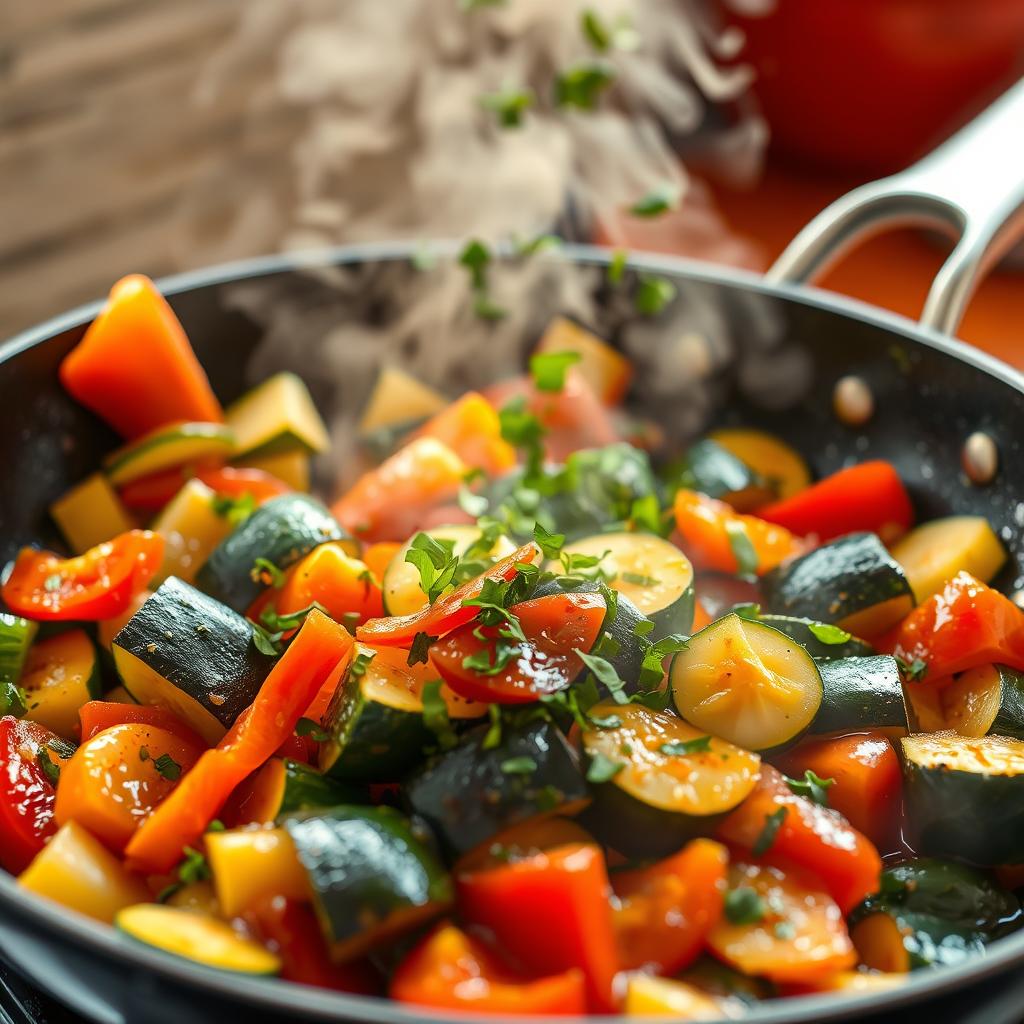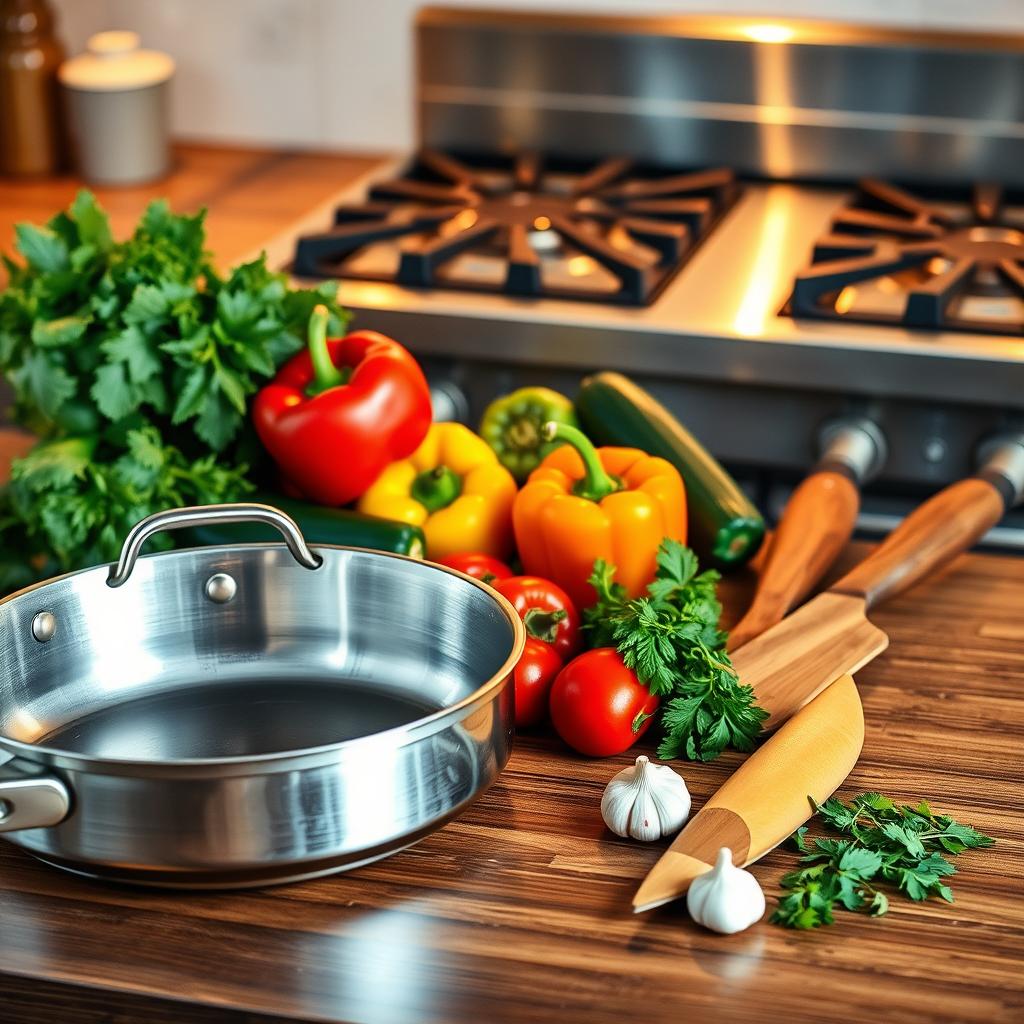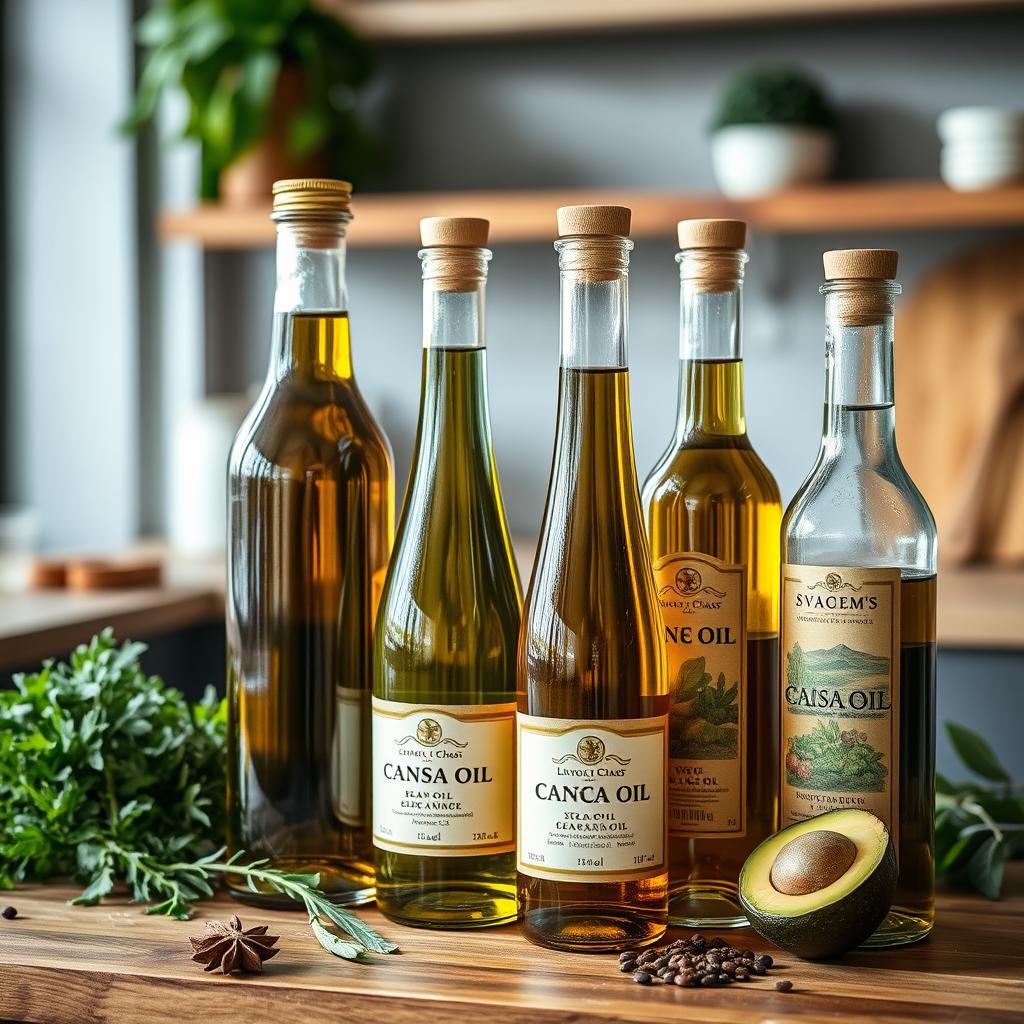Have you ever seen a chef toss ingredients in a hot pan with ease? They create a mix of smells and textures that’s amazing. Sautéing turns simple ingredients into delicious dishes. You can learn to how to sauté like a pro, making your meals more flavorful and exciting.
Learn how to sauté is not just cooking; it’s a dance with your ingredients and the pan’s heat. It takes skill, but with the right tips, you can get better at it. Let’s dive into the secrets of sautéing and how to cook like a pro at home.
Table of Contents
Understanding the Sautéing Technique
Sautéing is a key cooking method used in both professional and home kitchens. It involves cooking ingredients quickly in a hot pan with a bit of fat. This method helps create rich flavors and a golden-brown exterior on the food.
What is Sautéing?
Sautéing is a cooking method done on the stovetop. It involves lightly frying ingredients in a shallow pan with a small amount of fat. The high heat browns and caramelizes the food’s exterior, keeping the inside tender and juicy. It’s great for cooking veggies, proteins, and pasta, making it a valuable skill for cooks at any level.
Benefits of Sautéing
The main advantages of how to sauté include quick cooking times, enhanced flavors, and nutrient retention. The high heat seals in the food’s juices and flavors, creating a tasty caramelized crust. This technique is perfect for achieving complex, restaurant-style flavors in your dishes.
Common Ingredients for Sautéing
Some common ingredients for how to sauté are:
- Vegetables: Mushrooms, onions, garlic, peppers, zucchini, and other tender veggies
- Proteins: Chicken, fish, shrimp, and thin cuts of beef or pork
- Aromatics: Mirepoix (a mix of onions, carrots, and celery), sofrito (garlic, onions, and herbs), and other flavor boosters
The versatility of how to sauté makes it essential for anyone wanting to improve their cooking skills. It’s a key technique for enhancing ingredient preparation and flavor development.

Essential Tools for Sautéing
Sautéing needs the right cooking tools to get the best results. The right pan is key, along with the right utensils and gadgets. Let’s look at the essential tools for mastering sautéing in your kitchen.
The Right Pan for Sautéing
It is essential to use a good saute pan or a pan with low sides. They allow moisture to evaporate and brown the ingredients well. Choose a cast iron, stainless steel, stainless steel or nonstick skillet, depending on your favorite recipe.
Necessary tools
- Wooden spoons or heat-resistant spatulas for stirring and flipping ingredients
- Tongs for handling delicate items like scallops or fish
- Slotted spoon for removing cooked items from the pan
Helpful Gadgets
- Kitchen thermometer to monitor meat temperatures
- Mandoline slicer for uniform vegetable cuts
- Pint and quart containers for efficient ingredient storage
The pan you choose greatly affects your sautéed dishes. Invest in quality cookware for the best results. Add essential utensils and gadgets to improve your sautéing skills. This way, you can make delicious, restaurant-quality meals at home.

Preparing Ingredients for Sautéing
Getting your ingredients ready is key to great sautéing. By preparing well, you can make your sautéed dishes better. Let’s look at how to prepare your ingredients for sautéing.
Tips for Cutting Vegetables
Uniform cuts are crucial for even cooking. Try to chop your veggies into similar sizes and thicknesses. This way, they cook evenly, making your dish taste better. Remember, the smaller the pieces, the quicker they’ll sauté.
Marinating Proteins
Marinating proteins before sautéing can add flavor and tenderness. Use a mix of oil, acid, and seasonings for the marinade. Let the proteins soak for at least 30 minutes, or up to 24 hours for the best taste.
Organizing Your Workspace
Use the French “mise en place” method to prepare everything before cooking. This means chopping veggies, marinating proteins, and having your pan, utensils, and seasonings ready. Sautéing moves quickly, so being organized is key to executing the process seamlessly.

With your ingredients prepped and your workspace organized, you’re ready to sauté like a pro. You’ll make quick, tasty meals with ease.
Choosing the Right Oil for Sautéing
Choosing the right cooking oil is key for sautéing. It affects flavor, smoke point, and nutrition. From ghee’s rich taste to extra-virgin olive oil’s floral notes, there’s a wide range to enhance your dishes.
Understanding Smoke Points
Smoke point is crucial when picking an oil for sautéing. Oils like avocado oil (520°F) and safflower oil (510°F) are great for high heat. But, oils like extra-virgin olive oil (320°F) and coconut oil (350°F) are better for lower heat or as a finishing touch.
Infusing Flavors
The oil you choose can add unique flavors to your dishes. Extra-virgin olive oil gives a fruity taste, while sesame oil adds a nutty aroma. Trying different oils can lead to exciting new flavors.
| Oil | Smoke Point | Flavor Profile |
|---|---|---|
| Extra-Virgin Olive Oil | 320°F | Fruity, peppery |
| Refined Olive Oil | 470°F | Mild, neutral |
| Avocado Oil | 520°F | Buttery, nutty |
| Sesame Oil | 410°F | Nutty, toasted |
| Coconut Oil | 350°F | Tropical, sweet |
| Ghee (Clarified Butter) | 485°F | Rich, buttery |
Knowing about smoke points and flavors helps you pick the best oil for sautéing. This ensures your dishes are perfect and full of great tastes and smells.

Steps to Master Sautéing
Learning how to sauté is a great skill for any home cook. It’s a fast way to cook food in a little oil or fat. This method makes food crispy on the outside and soft on the inside. Here are the key steps to get better at sautéing.
Heating the Pan Properly
How To sauté well?, the pan must be hot before adding food. It should be so hot that you can’t hold your hand near it for more than a few seconds. Then, add a bit of oil that doesn’t smoke easily, like avocado or grapeseed oil.
Adding Ingredients at the Right Time
When sautéing, add ingredients in the right order. Start with the longest-cooking items, like proteins or thick veggies. Then, add quicker items like leafy greens or herbs last. Keep all ingredients in one layer for even cooking and browning.
Stirring and Tossing Techniques
Good stirring and tossing are key for a perfect sauté. Use a wooden spoon or spatula to stir and toss gently. This ensures even cooking without burning. For a pro move, try pan-tossing by lifting the pan and tossing the food in the air, then catching it back.
“Sautéing is a quick and efficient way to cook a variety of foods, from proteins to vegetables. By mastering the right techniques, you can unlock a world of flavor in your everyday meals.”
The secret to great sautéing is finding the right balance between pan-frying and high-heat cooking. With practice and focus, you’ll soon be sautéing like a pro.
Flavoring Your Sautéed Dishes
Sautéing is great for quick cooking and adding delicious flavors. To make your sautéed dishes even better, use the right herbs, spices, and sauces. This way, you can turn simple recipes into amazing meals.
Herbs and Spices to Enhance Flavor
Fresh herbs add bright, fresh notes to your dishes. Try using basil, thyme, rosemary, and parsley towards the end. Dried herbs and spices should go in early to let their flavors grow.
Some great spices for sautéed foods include:
- Garlic powder or freshly minced garlic
- Onion powder or sautéed onions
- Paprika, chili powder, or cayenne for a touch of heat
- Cumin, coriander, or curry powder for an earthy, complex flavor profile
Who Should Use Sauces?
Sauces can really enhance your sautéed dishes. They add depth and richness. Try using a “post-marinade” technique for extra flavor without cross-contamination.
Timing for Adding Flavorings
When adding herbs, spices, and sauces, timing is key. Dried herbs and spices go in early to fully develop. Fresh herbs are best added last to keep their freshness. Sauces and glazes are added at the end, either in the pan or over the dish.
Mastering flavor layering in sautéed dishes can make simple ingredients taste amazing. Try different herb and spice mixes and get creative with sauces. This will help you create restaurant-style meals at home.
Common Mistakes to Avoid
Learning how to sauté can make your cooking better and your dishes taste like they’re from a restaurant. But, there are mistakes to avoid for the best results. Knowing these can help you make your sautéed meals healthier and tastier.
Underheating the Pan
One big mistake is not heating the pan enough. If it’s not hot, your food will steam instead of brown. This makes it soggy and not good to eat. Make sure your pan is hot before you add your food for a great healthy cooking method.
Overcrowding the Pan
Adding too much food at once is another mistake. It lowers the pan’s temperature, making your food steam instead of sauté. This can cause uneven cooking and no caramelized surface. Add ingredients in batches to avoid this.
Not Seasoning Properly
Seasoning is key for tasty sautéed dishes. Not seasoning enough can make your food taste bland. Season your ingredients at different stages to make sure your dish is full of flavor.
Avoiding these mistakes will help you get better at sautéing. You’ll impress your family and friends with your cooking techniques, kitchen tips, and healthy cooking methods.
Sautéing Techniques for Different Foods
Sautéing is a versatile cooking method that works well with many ingredients. It’s key to know how to sauté different foods right. This ensures the perfect texture and flavor.
Vegetables: Timing and Temperature
When sautéing veggies, think about their density and water content. Harder veggies like carrots or potatoes might need longer cooking or pre-cooking. Lighter, leafy greens should be added last to avoid overcooking.
Start with medium-high heat for a nice sear. Then, lower the heat to simmer gently. This helps veggies cook evenly.
Master sautéing with these expert recipe guides OR How to Sauté Like a Pro
Proteins: Searing vs. Cooking Through
For proteins like chicken, steak, or shrimp, you can sear or cook through. Searing uses high heat for a quick brown crust. It’s great for thin cuts.
Cooking through uses lower heat and stirring. It’s better for thicker cuts or fully cooked proteins.
Combining Ingredients for Depth of Flavor
When sautéing various ingredients, add them in order of cooking time. Start with onions or garlic, then add quicker-cooking items. This builds a rich, layered flavor.
This method is especially useful for one-pan meals. It’s the base for cooking techniques and ingredient preparation.
“Mastering the art of sautéing is a game-changer in the kitchen. It allows you to create vibrant, flavorful dishes with ease.”
Delicious Sautéed Dish Recipes
Sautéing is a versatile cooking technique that opens up a world of delicious recipe possibilities. Whether you’re looking for a quick and easy vegetable sauté, a perfectly sautéed chicken breast, or creative sautéed pasta dishes, these recipes showcase the power of this flavorful cooking method.
Quick and Easy Vegetable Sauté
For a simple yet satisfying vegetable sauté, try combining bell peppers, zucchini, and onions with a drizzle of olive oil and your favorite herbs and spices. This quick one-pan meal comes together in a matter of minutes and delivers a healthy dose of nutrients. Adjust the cooking time to your preferred texture, and feel free to experiment with other seasonal veggies for a unique twist.
Perfectly Sautéed Chicken Breast
Sautéing chicken breast is the key to achieving a golden-brown exterior and juicy, tender interior. Start by ensuring your pan is hot and the chicken is patted dry before adding it to the pan. Cook the chicken in batches if necessary to avoid overcrowding, and resist the urge to move it too often. This simple technique will result in a perfectly sautéed chicken breast that can be served as the main course or incorporated into other dishes.
Creative Sautéed Pasta Dishes
Elevate your pasta game by sautéing the ingredients before tossing them with cooked noodles. Start by sautéing garlic and your choice of vegetables in olive oil or butter, then add cooked pasta and a light sauce for a quick and flavorful one-pan meal. This approach allows the ingredients to meld together, creating depth of flavor in your sautéed pasta dishes. Experiment with different flavor profiles and ingredient combinations to find your signature sautéed pasta dish.

